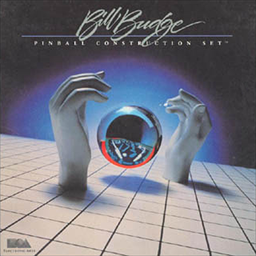
Pinball Construction Set is a video game by Bill Budge written for the Apple II. It was originally published in 1982 through Budge's own company, BudgeCo, then was released by Electronic Arts in 1983 along with ports to the Atari 8-bit computers and Commodore 64.

Pitfall! is a video game developed by David Crane for the Atari 2600 and released in 1982 by Activision. The player controls Pitfall Harry, who has a time limit of 20 minutes to seek treasure in a jungle. The game world is populated by enemies and hazards that variously cause the player to lose lives or points.
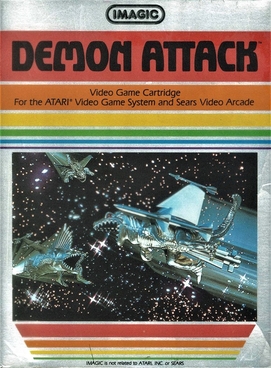
Demon Attack is a fixed shooter video game created by Rob Fulop for the Atari 2600 and published by Imagic in 1982. The game involves the player controlling a laser cannon from the surface of a planet, shooting winged demons that fly down and attack the player in different sets of patterns.
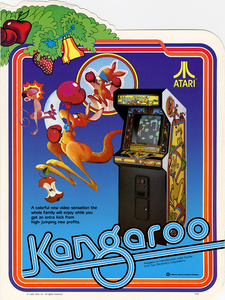
Kangaroo is a four-screen platform game released as an arcade video game 1982 by Sun Electronics and distributed in North America by Atari, Inc. Kangaroo is one of the first arcade games similar in style to Donkey Kong without being a direct clone. The player takes the role of a boxing glove-wearing mother kangaroo who is trying to rescue her joey from fruit-throwing monkeys. Jumping is integral to the game, but there is no jump button. Instead, the player pushes up on the joystick—or up and diagonally—to leap. The arcade version of Kangaroo has visible glitches in the graphics, such as sprites briefly flickering.

Deadline is an interactive fiction detective video game published by Infocom in 1982. Written by Marc Blank, it was Infocom's third game. It was released for the Amstrad CPC, Apple II, Atari 8-bit computers, Commodore 64, IBM PC, Osborne 1, TRS-80, and later for the Amiga and Atari ST.

Super Cobra is a horizontally scrolling shooter developed by Konami, originally released as an arcade video game in 1981. It was published by Konami in Japan in March 1981 and manufactured and distributed by Stern in North America on June 22. It is the spiritual sequel to the Scramble arcade game released earlier in 1981. Super Cobra contains eleven distinct sections, versus six in Scramble, and is significantly more difficult, requiring maneuvering through tight spaces early in the game.

Wizard of Wor is an arcade video game released in 1981 by Midway. Up to two players fight together in a series of monster-infested mazes, clearing each maze by shooting the creatures. The game was ported to the Atari 8-bit computers, Commodore 64, Atari 2600, and Atari 5200 and renamed to The Incredible Wizard for the Bally Astrocade. The original cartridge came with a cash prize offer to the first person to complete the game.
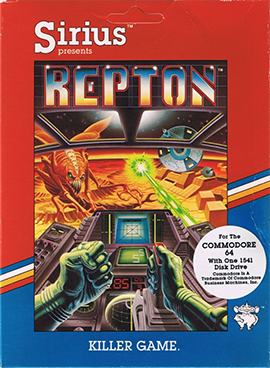
Repton is a Defender-inspired scrolling shooter written by Dan Thompson and Andy Kaluzniacki for the Apple II and published by Sirius Software in 1983. It was ported to the Atari 8-bit computers, and Commodore 64.

Hi-Res Adventure #6: The Dark Crystal is a graphic adventure game based on Jim Henson's 1982 fantasy film, The Dark Crystal. The game was designed by Roberta Williams and was the first Hi-Res Adventure directly released under the SierraVenture label in 1983. Versions were published for the Apple II and Atari 8-bit computers. An alternate version of the game intended for younger players called Gelfling Adventure was released in 1984.

Crossfire is a multidirectional shooter created by Jay Sullivan for the Apple II and published by On-Line Systems in 1981. Using keyboard-based twin-stick shooter controls, the player maneuvers a ship in a grid-like maze. Versions with joystick-control use the stick for movement and switch to firing mode when the button is held down.

Astro Chase is a multidirectional shooter written by Fernando Herrera for Atari 8-bit computers. It was published by First Star Software in 1982 as the company's first game. Parker Brothers licensed it, releasing cartridge versions for the Atari 8-bit family and Atari 5200 console in 1983 and a Commodore 64 version in 1984. Exidy licensed it for arcade use with its Max-A-Flex cabinet.

Megamania is a fixed shooter video game developed by Steve Cartwright for the Atari 2600. It was published by Activision in 1982. A pilot of an intergalactic space cruiser has a nightmare where his ship is being attacked by food and household objects. Using the missile launcher from their space cruiser, the pilot fends of the attackers. The game was later released for the Atari 5200 and Atari 8-bit computers.
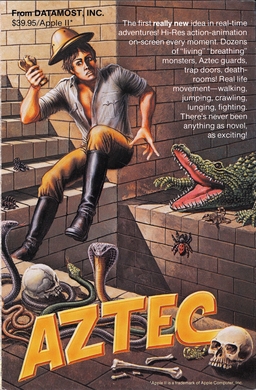
Aztec is an action-adventure game developed by Paul Stephenson for the Apple II and published by Datamost in 1982. It was ported to the Atari 8-bit computers and Commodore 64. In Aztec, the player enters and explores the recently discovered "Tomb of Quetzalcoatl" in Mexico in search of a jade idol.
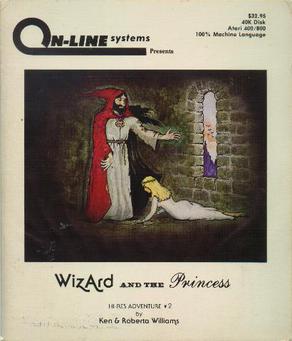
Wizard and the Princess is a graphic adventure game written for the Apple II and published in 1980 by On-Line Systems. It is the second installment in the Hi-Res Adventures series after Mystery House. Unlike its predecessor, which featured monochrome drawings, Wizard and the Princess introduced color graphics. Ports for the Atari 8-bit computers and Commodore 64 were released in 1982 and 1984 respectively. The 1982 self-booting disk version for IBM PC compatibles was renamed Adventure in Serenia.

Tutankham is a 1982 arcade video game developed and released by Konami and released by Stern in North America. Named after the Egyptian pharaoh Tutankhamun, the game combines a maze shoot 'em up with light puzzle-solving elements. It debuted at the European ATE and IMA amusement shows in January 1982, before releasing worldwide in Summer 1982. The game was a critical and commercial success and was ported to home systems by Parker Brothers.

Transylvania is an adventure video game published by Penguin Software. It was released for the Apple II in 1982 followed by ports to the Atari 8-bit computers and Commodore 64. A Mac conversion was published in 1984, then versions for the Amiga, Atari ST, and MS-DOS in 1985.

Preppie! is an action video game for Atari 8-bit computers published by Adventure International in 1982. It was programmed by Russ Wetmore of Star Systems Software, whose name is prominently displayed on the box cover. Leaning on the preppy trend of the early 1980s, the game follows prep schooler Wadsworth Overcash as he navigates the hazards of a country club to retrieve golf balls. Preppie! borrows heavily from Konami's Frogger, with lanes of traffic in the bottom half of the screen and a river crossing the top portion. Alligators are an element from both Frogger and preppy fashion; an open-mouthed gator is the icon of shirt brand Izod. Reviewers recognized the game as derivative, but called the music and visuals some of the best for Atari 8-bit computers.
Russ Wetmore is an American programmer and video game designer best known for writing commercial games and applications for Atari 8-bit computers in the early to mid 1980s. His Frogger-inspired Preppie! was published by Adventure International and praised by reviewers for the music and visuals. He also wrote the maze-game sequel, Preppie! II. Wetmore stopped writing games after the video game crash of 1983 and developed the integrated HomePak productivity suite for Batteries Included. He has remained in software development in director and architecture roles.

Axis Assassin is a video game written by John Field for the Apple II and published by Electronic Arts in 1983. Ports for Atari 8-bit computers and Commodore 64 were released alongside the Apple II original. The game is similar in concept and visuals to Atari, Inc.'s 1981 Tempest arcade video game.



















